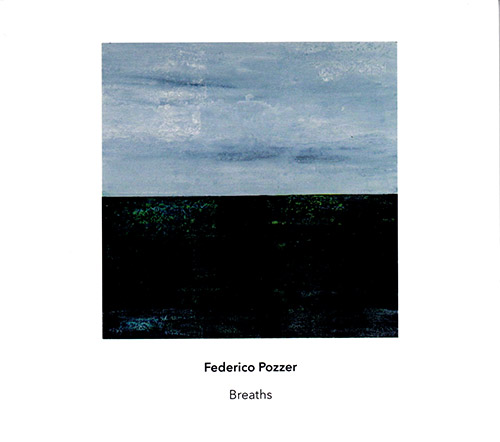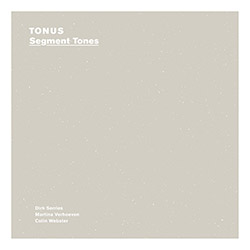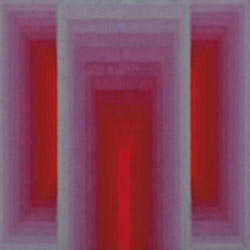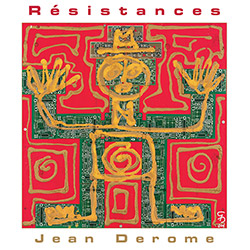
Three works from Italian composer and pianist Federico Pozzer in his "breathing" series, compositions where the musicians follow the concept of inhaling, exhaling, and pausing, set against certain fixed actions or interactions as they devise their own musical actions, the goal to overcome both the players' freedom in decision-making and strictness in the score.
Out of Stock
Quantity in Basket: None
Log In to use our Wish List
Shipping Weight: 3.00 units
Sample The Album:
Federico Pozzer-piano
Lucio Tasca-guitar
Dejana Sekulic-violin
Colin Frank-vibraphone
Kathryn Williams-flute
Brice Catherin-cello
Click an artist name above to see in-stock items for that artist.
Label: Another Timbre
Catalog ID: at141
Squidco Product Code: 27573
Format: CD
Condition: New
Released: 2019
Country: UK
Packaging: Cardboard Gatefold
No recording data listed.
"My first 'breathing pieces' were written at the end of 2016.... I was looking for a solution that could overcome both the players' freedom in decision-making and the strictness of the score. What I wanted was to lead musicians towards a grounded connection with the temporal dimension of their playing, and a more present way of making music."-Federico Pozzer
"Another Timbre Interview with Federico Pozzer
Tell us about your background in music.
I started classical piano when I was 8 and then around the age of 15 I got into improvised music. I studied jazz both privately and at the Conservatory of Vicenza, close to my hometown, in Italy. In 2013 I moved to Groningen in Holland, where my musical interests definitely started to change. I really got into Misha Mengelberg, the ICP Orchestra and the free improv scene, and I wrote the first pieces that could not be really identifiable as jazz pieces. However, a couple of years later I discovered Feldman, and later on Bunita Marcus and Cage, and I just started to be very interested in their stuff. In 2016, I eventually moved to Leeds to attend the Critical and Experimental Composition Master Course led by the composer Scott McLaughlin. There I felt immersed in a very stimulating musical environment, and also a quite new one for me. We were encouraged to work on our own compositional research but at the same time we got to know the music of Cardew, Oliveros, Wolff, James Saunders, G Douglas Barrett, Gavin Bryars etc. That was really exciting.
Can you say a bit about how 'Breath II' works? And how did you become interested in breathing patterns?
Well, in this piece breathing acts as a time regulator. Each breath is divided into three different phases: inhaling, exhaling, and a pause. In the piece these three phases basically work as time cycles, flexible and mutable bars. Both piano and guitar are playing one action within each phase, so the musicians have to be constantly aware of their own breathing. The thing is that breathing is flexible; it contracts or stretches according to the player, and the lengths of the breathing phases are not the same for each player. Consequently this approach brings to the surface indeterminate and always changing combinations of sounds of different durations.
Honestly, I am not really sure how I became interested in that. My first 'breathing pieces' were written at the end of 2016 or the beginning of 2017. Back then, I think I was looking for a solution that could overcome both the players' freedom in decision-making and the strictness of the score. What I wanted was to lead musicians towards a grounded connection with the temporal dimension of their playing, and a more present way of making music, and I thought that asking them to match musical actions to breathing could be a useful way of achieving this kind of situation.
Yes, I think it's very effective, and gives an interesting, staggered rhythm to the music. But what about the tones themselves - how did you determine them in this piece? There are obviously certain notes and intervals that are repeated, but is there a system or is it intuitive?
Basically the score has the following structure: A,B,C,D,E,F,E',D',C',B',A' and in this recording we repeat it three times. The amount and the types of sounds per section are the same for both instruments, though in the piano part the order of sounds is reversed. About the tones, the score includes a series of symbols, that can indicate explicit melodic intervals, registers, harmonics, glissandi etc. However pitches are never specified, they are completely up to the players. Before the beginning of the performance, the pianist and guitarist should arrange their own set of sounds independently and once decided, the musicians should always keep the same sounds every time the symbols recur in the score. The melodic intervals are all ninth intervals related together through half-step motions.
Tell us about 'Meetings', which also uses breathing patterns. How does that one work?
'Meetings' works differently from 'Breath II' in that it involves a higher degree of interaction between musicians, with different musicians 'leading' the music at different points according to instructions in the score. Depending on the section, one or two of the musicians are asked to change note when they hear the exhalation of the lead player, so they are pushed to listen carefully, while the musician who is leading at any time has to make clear to the other(s) that she/he is exhaling. When they are not interacting, musicians repeat the same pitch following the tempo given by their own breathing. What interested me was the fact that when players are not asked to communicate with each other, they breathe normally, in their own way. However, when musicians interact with each other, their breathing is in some way shaped by the responsibility to the others, by the need to be heard by the other players.
In terms of pitches, each musician plays following a specific major descending or ascending scale: guitar Bb, violin D, and piano F#. However, the fact that musicians' playing is always combined together makes these specific tonal centers hardly perceivable by the listener. In certain circumstances, the number of notes played by the lead player can also affect the number of notes the other musician(s) will play, so the duration of these notes change according to the length of the lead player's exhalation and his/her choices.
And what about 'Noises', how is that organised?
'Noises' is actually the only piece where just one of the musicians in the ensemble plays according to their breathing patterns. While the pianist's notes last the length of his/her inhalation or exhalation, the other musicians play when they hear external sounds from the environment, both within the hall and from outside. So, the piece is played with the doors and windows of the performance space open. Depending on the type of sound-source that produces an extraneous sound (inanimate or animate object), the musicians react in different ways (changing playing technique, or changing instrument in the case of the percussionist). However, all the players follow the chromatic scale.
The instructions in the score are simple in themselves but open to interpretation. For example, regarding the type of response to external sounds, the performer may wonder 'if a sound repeats, should I always react to it'? or 'if two different sounds are heard at the same time, let's say almost overlapped, should I react to both?' So, the number of reactions might be quite different between players. On the other hand, I was very concerned about the immediacy of the response; I wanted players to react in a relaxed and controlled way. The awareness of the musical-action should always be present and the musicians that played in the recording on the CD did a really great job with this."
Artist Biographies
• Show Bio for Federico Pozzer ^ Hide Bio for Federico Pozzer • Show Bio for Lucio Tasca "Lucio Tasca is a composer, guitarist and improviser born in Palermo (Sicily), based in UK. His practice attempts to create immersive listening experiences, exploring the objectivity of formal repetitive processes and the use of fragile and unstable material to foster a subtle dialectical layer of nuances and little imperfections." ^ Hide Bio for Lucio Tasca • Show Bio for Dejana Sekulic "Dejana Sekulić was born on 43°18'58.5"N 21°54'39.5"E where her musical education started in the Musical School, under the supervision of eminent professor Branislava Petrović Marković, most of whose students became appreciated performers or educators. Their fruitful cooperation lasted until Dejana graduated at the High School for Music "Vojislav Vučković" as the top student of her class. After that she went to study in the class of professor Igor Aleksić at the Faculty of Music at the University of Niš, where again she was as a top student. She continued her studies and obtained Masters degree and Postrgraduaat in Music on Royal Conservatory of Brussels in the class of professor Valery Oistrakh and Bart Bouckaert, after which she bacame part of the advanced fellow program for contemporary music of the Ictus (Brussels) and Spectra (Gent) Ensembles at School of Arts Gent. Furthermore, she participated in several master classes, held throughout Europe, by renowned violinists, as well as numerous competitions, where she was, almost as a rule, ranked amongst the best. She worked and collaborated with masters such as Igor Oistrakh, Ruggiero Ricci, Vladimir Spivakov, Eugenia Tchugayeva, Marc Danel, Stefan Camilarov, Ilan Gronich, Mihail Grube, Dejan Mihailović, Angel Satnkov, Barbara Maurer, Peter Ablinger, Tom Pauwels, Filip Rathe, Graeme Jeannings, Bram Bossier, George van Dam, Pieter Jansen. During this time she has been performing regularly in Serbia and in Belgium, as well as in Italy, Slovenia, Switzerland, Austria, Spain, Bulgaria, Germany, France, Portugal, USA and China. Her recent solo performances include concerts on the "ArsMusica" International Contemporary Music Festival (Belgium), Epidaursu Festival (Croatia), concert during the "Museum Nigh Fever" in Palais des Beaux-Arts (Brussels), "Constantinus Festival" (double violin concertos with Valery Oistrakh), BigBang Festival (with ICTUS+GAME), concerts in Flagey (Brussels) and the MiM (Musical Instruments Museum, Brussels), deSINGEL (Antwerpen), performances on TRANSIT and LOOP festivals (with LAPS). Beside solo and ensemble performances, very wide and vivid chamber music engagements, her work with several orchestras has also being noted through time. She played with "Constantinus Chamber Orchestra" from Serbia, Symphony Orchestra of Niš, Brussels Philharmonic Orchestra, "Timur und seine Mannschaft", SymphoniaASSAI. She is the founder, musician and member of artistic council behind "deACT", 2010 -collective that gathers eight musicians for performing, in different combinations, chamber music repertoires as well as new and special projects. She also did several recordings for both Serbian and Italian radio and TV broadcasting companies. Dejana is the violinist in LAPS ensemble, ensemble that works with combining acoustic and electronic production of sound. She also plays in the violin and piano duo, with pianist Nao Momitani and a duo with harpist Maria-José Jeannin (duo "MaD"). Currently, she is working on a PhD research "Temporality of the Impossible: contemporary violin music, aesthetics, technique and performance" at the CeReNeM and HuCPeR, at the University of Huddersfield (UK). Her other artistic works include also a research in the filed of interactive sound installations. More specifically "Sensonarium" (with support of Q-O2 Brussels and ISIB-Institut Supérieur Industriel de Bruxelles), that is, besides being autonomous work also part of her concept "microMACRO" (performance for solo instrument and sound installations)." ^ Hide Bio for Dejana Sekulic • Show Bio for Colin Frank "Colin Frank (CAN/UK) experiments with sound, electronics, theatre, and percussive instruments. In attempting to blur delineations between composer, performer, improviser, and technician his practice perpetually mutates: narrowly focusing then sprawling chaotically. His art investigates excess, pushing the body to physical extremes, barely controllable instruments, and rich, raw noises. He has most notably performed in the Huddersfield Contemporary Music Festival (UK), Berlin's CTM festival (DE), the Darmstadt Internationale Ferienkurse für Neue Musik (DE), Electric Springs (UK), SoundThought (UK), PAS Quebec Days (CAD), and the Oorsprong curators series (NL). His specialism performing live-electronic concert music has brought him to present in the Birmingham Electro-Acoustic Sound Theatre (UK) and the Huddersfield Immersive Sound System (UK). He has performed within theatre troupe Gods Entertainment (AT), improvised with the Sonology Electroacoustic Ensemble (NL), and is a core member of the Drift Ensemble (UK). His instrumental and acousmatic compositions have been presented by TAK Ensemble (US), The Red Note Ensemble (UK), Lights Out Listening Group (UK), and Framework Radio (online). He studied performance and composition at McGill University, sound at the Institute of Sonology (NL), composition at the Internationale Ferienkurse für Neue Musik (DE) and SoundSCAPE (IT), and performance at Nief-Norf Summer Festival (US) and SICPP (US). He is currently studying contemporary performance practice through a research PhD at The University of Huddersfield (UK). He enjoys teaching improvisation, cycling, camping, traveling, and good home cooking." ^ Hide Bio for Colin Frank • Show Bio for Kathryn Williams "Kathryn Williams is a flautist who performs solo recitals, chamber music, and with orchestras with a particular interest in new and experimental music. Recent performances include a Stockhausen masterclass with Kathinka Pasveer at Theater Basel, solo and chamber music performances with Ensemble Linea Academy at Cité de la musique et la danse Strasbourg, and a concerto with Manchester Camerata. She has performed with various orchestras including the BBC Philharmonic, The Hallé, Royal Liverpool Philharmonic, and Sinfonia Cymru and plays regularly with new music group The House of Bedlam. Kathryn's current project, Coming Up for Air, has been selected for YCAT's Sounding Board: Project Mentoring. As a music educator Kathryn specialises in experimental performance practice and early-years education. Recently this has included guest lecturing at the Royal Northern College of Music, contributing to courses with Aldeburgh Young Musicians, delivering performances and workshops for Live Music Now, and long-term residencies at Alder Hey Children's Hospital, Manchester Museum and in a central Manchester nursery school. Kathryn earned a BMus, MMus, and International Artist Diploma from the Royal Northern College of Music with teachers Peter Lloyd, Richard Davis, Katherine Baker, Stephen Preston, Karin de Fleyt and others. Prizes include RNCM Bach Prize, RNCM Concerto Competition (on two occasions), British Flute Society Young Artist Competition, and National Foundation for Arts Award (USA)." ^ Hide Bio for Kathryn Williams • Show Bio for Brice Catherin "Brice Catherin (born 16 October 1981 in Brussels, Belgium) is a French composer and cellist. Brice Catherin studied the cello at the Haute Ecole de Musique de Lausanne (Switzerland) with professor Marc Jaermann (cellist of the sine nomine quartet) where he successfully completed his diploma in 2004. At the same time, he was studying composition at the Haute École de Musique of Geneva (Switzerland) with professors Michael Jarrell, Luis Naón and Éric Daubresse. He received his diploma in 2005. The following year he studied at the Basel Musikhochschule with professor Roland Moser. During this period, Brice Catherin gave a few hundred concerts and performances as a cellist, a composer, an improviser, and a performance artist in Europe, Japan, Russia, Iceland and Canada as an independent artist. He composed about 80 works for soloists to big ensembles, from 10 minutes to 10 hours. He premièred a few works he commissioned for solo cello or chamber ensembles to composers such as Dror Feiler, Christian Rosset, Evis Sammoutis, Patricia Bosshard, Baudoin de Jaer, Abby Swidler, Jacques Demierre, Arash Yazdani and Ludovic Thirvaudey. He worked with artists from various backgrounds: dancers (Foofwa d'Imobilité, Corina Pia, Judith Desse...), writers (Karelle Ménine, Cléa Chopard...), actors (Delphine Rosay...), and after works of movie directors (David Bestue and Marc Vives, David OReilly (artist)...) and illustrators (Yuichi Yokoyama...) As a composer, Brice Catherin wrote more than 80 instrumental works with or without electronic. As an improviser, he is known for engineering the concept of "improvisation laboratories", which refers to performances of constrained improvisations. The constraints can be as different as "playing an instrument you don't know", "playing a building", "improvise music for a cartoon", "improvisation of characters", or "mixing baroque music and free improvisation". " ^ Hide Bio for Brice Catherin
11/20/2024
Have a better biography or biography source? Please Contact Us so that we can update this biography.
11/20/2024
Have a better biography or biography source? Please Contact Us so that we can update this biography.
11/20/2024
Have a better biography or biography source? Please Contact Us so that we can update this biography.
11/20/2024
Have a better biography or biography source? Please Contact Us so that we can update this biography.
11/20/2024
Have a better biography or biography source? Please Contact Us so that we can update this biography.
11/20/2024
Have a better biography or biography source? Please Contact Us so that we can update this biography.
Track Listing:
1. Breath II 34:08
2. Noises 10:34
3. Meetings 16:31
Compositional Forms
Improvised Music
NY Downtown & Metropolitan Jazz/Improv
Duo Recordings
Sextet Recordings
Trio Recordings
Ambient, Minimal, Reductionist, Onky Sound, &c.
New in Compositional Music
Search for other titles on the label:
Another Timbre.


















![Guy, Barry / Ken Vandermark: Occasional Poems [2 CDs]](https://www.teuthida.com/productImages/misc4/34849.jpg)
![Novoa / Carter / Mela Trio: Vol.1 [VINYL]](https://www.teuthida.com/productImages/misc4/35236.jpg)


![Elephant9 : Mythical River [VINYL]](https://www.teuthida.com/productImages/misc4/34624.jpg)
![Evans, Peter (Evans / Eldh / Black): Extra [VINYL]](https://www.teuthida.com/productImages/misc4/35279.jpg)

![McPhee, Joe: Straight Up, Without Wings [BOOK]](https://www.teuthida.com/productImages/misc4/35454.jpg)
![Jeck, Philip: rpm [2 CDs]](https://www.teuthida.com/productImages/misc4/35455.jpg)













![Barker / Parker / Irabagon: Bakunawa [VINYL]](https://www.teuthida.com/productImages/misc4/35533.jpg)
![Blaser, Samuel / Marc Ducret / Peter Bruun: Dark Was The Night, Cold Was The Ground [VINYL 10-inch]](https://www.teuthida.com/productImages/misc4/35492.jpg)








![Warren, Kenny (Warren / Hoffman / Ellman): Sweet World [VINYL]](https://www.teuthida.com/productImages/misc4/35451.jpg)




![Blake, Ran / Dave Knife Fabris: Live Amsterdam 2006, First Visit [CD + POSTCARDS]](https://www.teuthida.com/productImages/misc4/35275.jpg)













![DNS: Taking Big Bites Of The Khandas Three Cafes Deep [2 CDs]](https://www.teuthida.com/productImages/misc4/35334.jpg)




![Cleaver, Gerald: The Process [VINYL]](https://www.teuthida.com/productImages/misc4/34966.jpg)




![Alva Noto: HYbr:ID II [VINYL 2 LPs]](https://www.teuthida.com/productImages/misc4/35201.jpg)

![Baron, Derek / Luke Martin: Distinct and Concealed [CASSETTE + DOWNLOAD]](https://www.teuthida.com/productImages/misc4/35079.jpg)

![Lyle, Erica Dawn : Colonial Motels [CASSETTE + DOWNLOAD]](https://www.teuthida.com/productImages/misc4/35080.jpg)









![Sanna, Claudio: Compositori Sardi Contemporanei II [2 CDs]](https://www.teuthida.com/productImages/misc4/35317.jpg)







![Zurria, Manuel: Fame di Vento [3 CDs]](https://www.teuthida.com/productImages/misc4/35167.jpg)

![Granberg, Magnus / Nattens Inbrott / Skogen: Holde Traume, Kehret Wieder! [2 CDs]](https://www.teuthida.com/productImages/misc4/35038.jpg)
![Frey, Jurg: Outermost Melodie [2 CDs]](https://www.teuthida.com/productImages/misc4/35039.jpg)

![Pavone, Jessica: Reverse Bloom [VINYL]](https://www.teuthida.com/productImages/misc4/34895.jpg)




![Modney (Modney / Wooley / Gentile / Roberts / Pluta / Symthe / ...): Ascending Primes [2 CDs]](https://www.teuthida.com/productImages/misc4/34852.jpg)









![Elephant9 with Terje Rypdal: Catching Fire [VINYL 2 LPs]](https://www.teuthida.com/productImages/misc4/35355.jpg)
![Deerlady (Obomsawin, Mali / Magdalena Abrego): Greatest Hits [VINYL]](https://www.teuthida.com/productImages/misc4/34876.jpg)




![Haino, Keiji: Black Blues [2 CDs]](https://www.teuthida.com/productImages/misc4/35109.jpg)



![Surplus 1980: Illusion of Consistency [CD]](https://www.teuthida.com/productImages/misc4/35069.jpg)
![Staiano, Moe: Away Towards the Light [VINYL + DOWNLOAD]](https://www.teuthida.com/productImages/misc4/35037.jpg)



![Caveira (Gomes / Sousa / Abras / Ferrandini): Ficar Vivo [VINYL]](https://www.teuthida.com/productImages/misc4/34643.jpg)
![Gregg, J. J. / David Van Auken: Lunar Prairie [CD w/ DOWNLOAD]](https://www.teuthida.com/productImages/misc4/34611.jpg)

![Coultrain: Mundus [VINYL]](https://www.teuthida.com/productImages/misc4/32439.jpg)
![Mattin: Songbook #6 [VINYL]](https://www.teuthida.com/productImages/misc4/27317.jpg)
![Punkappella: Wake Up [7-inch VINYL]](https://www.teuthida.com/productImages/misc4/17519.jpg)
![Residents, The: WARNING: UNiNC.: Live And Experimental Recordings 1971-1972 [VINYL 2 LPs]](https://www.teuthida.com/productImages/misc4/31521.jpg)
![Coultrain: Phantasmagoria [VINYL]](https://www.teuthida.com/productImages/misc4/30142.jpg)
![Lennon, Sean Ono: Asterisms [VINYL]](https://www.teuthida.com/productImages/misc4/34517.jpg)

![Coley, Byron: Dating Tips for Touring Bands [VINYL]](https://www.teuthida.com/productImages/misc4/17906.jpg)

![Lost Kisses: My Life is Sad & Funny [DVD]](https://www.teuthida.com/productImages/misc4/lostKissesDVD.jpg)